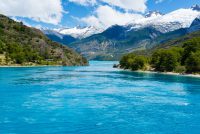Chile is a country that forges an excellent balance between an adventurous and luxurious honeymoon. Its long, thin form, which extends from the Peruvian border in the north and curls around towards Argentina and the Southern Ocean in the south, provides an equally captivating mixture of climates and environments. Every possible type of Chile honeymoon can be found on these shores, from romantic thermal springs, to ancient artifacts and nights beneath a flawless canopy of stars.
You may also like the article: Unusual Patagonia Honeymoon Destinations.
When should you take your Chile honeymoon?
The temperate Mediterranean climate around the capital Santiago and the middle regions of Chile makes summer days long and hot and winters still mild and often sunny. In the north, the cold desert climate means warm conditions prevail year round, although at altitude it can get particularly cold.
The southern hemisphere’s spring and summer seasons (September through to April) are the time period most favored by visitors to the south and Chilean Patagonia. Snowfall in this region during the winter months can make travel difficult, but not entirely impossible.
Geysers, hot springs, and flamingoes in the Atacama Desert
One of the country’s most popular destinations, the Atacama Desert in the north is an unusual but inspired Chile honeymoon choice. Flamingoes paddle in salt waters beside the country’s largest salt flats, while smoking volcanoes ring the desert plains.
Couples can marvel at sunset over the otherworldly landscape of El Valle de La Luna (the Valley of the Moon) or dawn at the El Tatio Geysers as steam billows into the sky. Hot thermal springs for a relaxing dip and stargazing tours to observatories with access to unobstructed views of the night’s sky complete the attractions of Atacama.
 The Elqui Valley: pisco distilleries and star gazing
The Elqui Valley: pisco distilleries and star gazing
Around six hours north of Santiago, the Elqui Valley has found international fame as Chile’s principal pisco producing region. This South American liquor is a product of the vineyards which crisscross the valley and the patchwork of boutique and larger-scale distilleries located here. Honeymooners can get a flavor of Chile’s most delicious spirit through tours of and tasting sessions in the many distilleries.
Like Atacama in the north, the Elqui Valley is also regarded as one of the globe’s premier stargazing destinations. With only a handful of cloudy days per year, the conditions here are ideal, and nightly tours with expert guides are an unmissable way of learning more about the universe.
Culture, beaches and fine dining in Valparaiso, Viña del Mar and Santiago
Valparaiso, around an hour’s drive from Santiago, takes the title as Chile’s most bohemian city. A sprawling hub of street art lined roads set over hills that plunge into the sea below, it has a thriving night scene, broad range of museums (check out Nobel Prize-winning poet Pablo Neruda’s house, La Sebastiana) and relaxed ambience. Nearby Viña del Mar is known for its white sand beaches which are ideal for relaxing during your visit to the country.
 Chile’s capital city, Santiago, has grown in status as one of South America’s most exciting cities for world-class cuisine. Santiago’s restaurants offer luxurious fine-dining options that make the most of locally-sourced, Chilean produce; and are an unmissable part of a honeymoon in this country.
Chile’s capital city, Santiago, has grown in status as one of South America’s most exciting cities for world-class cuisine. Santiago’s restaurants offer luxurious fine-dining options that make the most of locally-sourced, Chilean produce; and are an unmissable part of a honeymoon in this country.
Ancient artifacts on Easter Island
Perhaps the most mystical of all of Chile, Easter Island was once the setting for a unique civilization with Polynesian routes and its own language. The most symbolic features of Easter Island are undoubtedly the monolithic moai statues carved into the shape of giant human figures that stand solemnly around the island.
But the allure of Easter Island doesn’t stop there. Combining various museums, ancient ceremonial grounds and giant volcanic craters to visit, it’s a truly unique destination for a Chile honeymoon.
National parks and UNESCO World Heritage buildings on Chiloé
Chiloé is a delightful archipelago that shows a distinctive side of Chile. Still home to traditional villages filled with fishermen and farmers, it’s the remote national park on the west coast of the island and the shingle-roofed, brightly-colored houses on stilts (called palafitos) in the town of Castro that understandably draw the crowds.
 A honeymoon here would also be incomplete without a visit to the island’s wooden churches – sixteen of which gained UNESCO World Heritage status in 2001. Their distinctive architecture and incredible endurance against the harsh sea winds that can plague the archipelago are a symbol of Chiloe’s resilience against time and the elements.
A honeymoon here would also be incomplete without a visit to the island’s wooden churches – sixteen of which gained UNESCO World Heritage status in 2001. Their distinctive architecture and incredible endurance against the harsh sea winds that can plague the archipelago are a symbol of Chiloe’s resilience against time and the elements.
No comments yet
There are no comments on this post yet.






Leave a comment